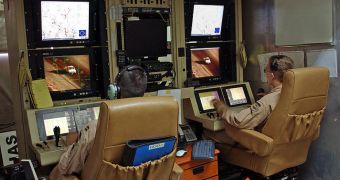In a bid to reduce the physical involvement of military personnel in dangerous surveillance operations in conflict zones, experts have taken to developing new observe-and-report technologies that do not include humans. Their main focus is on the class of machines known as Unmanned Aerial Vehicles (UAVs), basically remote-controlled planes with weapons and cameras. UK researchers from the Cranfield University are currently working on refining a new method of conducting surveillance that would allow UAVs to plan and verify missions on their own, without needing human assistance.
The new research project was developed at the Defense Academy of the United Kingdom, with funding secured from the Engineering and Physical Sciences Research Council (EPSRC). The new computer framework was actually designed to support the operation of multiple unmanned aerial vehicles (MUAV) at the same time. The system is relatively simple. An individual in a safe position on the ground controls a larger number of UAVs, which conduct surveillance and reconnaissance of a target area. The future could see making these aircraft capable of producing “kill boxes” as well, if the reconnaissance stage of the mission fails, and the robotic planes come under fire. In addition, EPRSC officials say, this innovation could make surveillance missions a lot cheaper and safer.
The thing that hampered this approach at first was the fact that the MUAVs needed to fulfill some very strict requirements as to their flight capabilities. Flying them in crowded and/or dangerous skies meant that they had to have a guaranteed, top-of-the-line performance, as well as a very sophisticated control algorithm. What the team did, in cooperation with colleagues from the Imperial College London (ICL), was develop a computerized framework that made the MUAV fleet responsible for completing the mission. The vehicles are given a task, a mission objective, and are then authorized to conduct the necessary maneuvers to complete that particular task.
However, the role of the human operator stops here. The computer algorithm is then left in charge of deciding the safest, fastest, most efficient approach to solving the mission objective. Issues such as navigation, guidance, path planning and decision making are controlled by the computer, which also makes the necessary flight adjustments within the flight formation so as to avoid the UAVs' in a group colliding with each other, or impacting buildings.
“We have to be absolutely certain of the behavior of the UAVs if they are operating over civilian areas or in a battle situation. Missions sometimes have to be abandoned due to poor weather or on safety grounds, but pilotless vehicles can be used in more challenging situations and can also provide real-time feedback on current conditions,” Professor Antonios Tsourdos, the principal researcher on the new computer framework, says.

 14 DAY TRIAL //
14 DAY TRIAL //